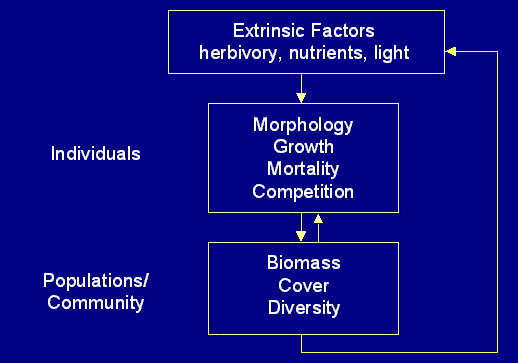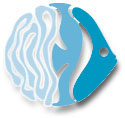| ABM of Macroalgae
Macroalgae are important components of the coral
reef. They are part of the benthic community that play roles in productivity
and framework build-up. Their interactions with other benthos, particularly
hard corals are also of interest due to the widespread recognition that a
phase shift has occurred, and is still occurring in coral reefs. That
is, the abundance of hermatypic corals decreases, as large fleshy macroalgae
increase. Thus, it is important to understand the mechanisms of this
phase shift as they pose a big impact on reefs. This phenomenon can be
approached by elucidating the dynamics of the macroalgal community, as well
as their competitive interactions with corals. An ABM model will attempt to
capture these dynamics using information obtained from both comprehensive
literature mining and field work.
The agent-based simulation
modeling approach is appropriate for depicting the dynamics of benthic
macroalgae because it can incorporate space and local interactions that have
been shown to be important. This approach has also been successfully applied
to forest simulation modeling, e.g., the SORTIE forest model ( (Deutschman
et al. 1997) ) and the U.S. Department of Agriculture Forest Vegetation
Simulator.
This model would represent
macroalgae � whether as species or as functional group � such that their
growth pattern would be captured. Figure 1 illustrates the simple
growth pattern of a filamentous alga using its modular units as building
blocks. Collado-Vides et al. (1997) have simulated the clonal growth of
Bostrychia radicans, a species associated with mangrove roots, using
architectural growth rules and Lindenmayer systems.

Fig. 1. Simple
model of the growth pattern of a filamentous algae where the repeating module is
a single cellÂ
represented by a single line.
These
individual level characteristics of morphology, growth, mortality and
competitive ability of different macroalgal groups would be programmed as
affected by extrinsic factors like herbivory, nutrients and light. Then from the
interaction of the organisms, the population and community-level dynamics of
biomass, cover, and diversity would be observed.Â
These
higher order dynamics could then feedback on the extrinsic factors (Figure 2).

Figure 2. A preliminary concept of what the model will attempt to capture.
A
Java2-based prototype of the agents as described above will be made available in
this page.
References
Collado-Vides, L., G. G�mez-Alcaraz, G.
Rivas-Lechuga, and V. G�mez-Gutierrez. 1997. Simulation of the clonal growth of
Bostrychia radicans (Ceramiales-Rhodophyta)
using Lindenmayer systems. BioSystems 42:19-27.
Deutschman,
D. H., S. A. Levin, C. Devine, and L. A. Buttel. 1997. Scaling from trees to
forests: analysis of a complex simulation model. Science Online.
...top |
 NCORE
NCORE